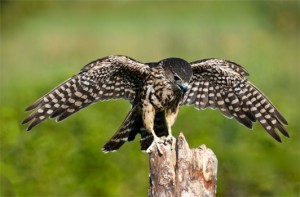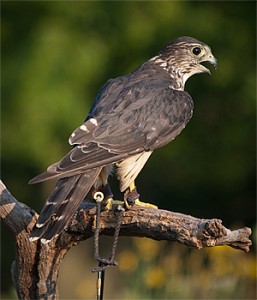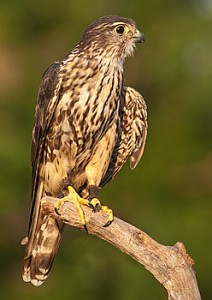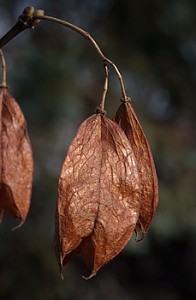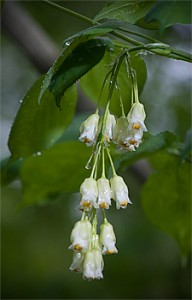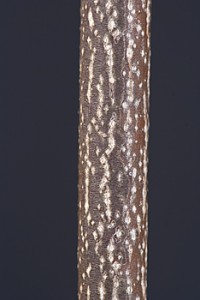The Merlin is a Blue Jay size falcon. The females are noticeably larger than the males. The males are more colorful possessing a blue-gray back as opposed to the brown back of the female. Like all falcons, they have pointed wings, that they beat rapidly, and a long tail. They lack the brownish color of a Kestrel and never hover to hunt. Their faint “sideburns” and the narrow tail-bands distinguish them from the larger Peregrine Falcon. The “sideburns” on Peregrine Falcons are distinct and their tail-bands are much wider than a Merlin’s.
The photographs are of a captive female bird kept at the Outdoor Discovery Center in Holland, Michigan. This group sponsors many fine educational programs for all ages including birds of prey photo shoots.
Merlins (Falco columbarius) are increasing their breeding range in Michigan. There are two areas near Grayling, Michigan where I regularly see them. However, I have not found a nest or seen young but the birds are around all summer.
Historically, they probably nested in the Upper Peninsula. The first nests found were in the mid-1950s. Their population crashed (along with most raptors) in the 1960s due to DDT and other pesticides. The first Michigan Breeding Bird Atlas survey, during the 1980s, recorded Merlins from 72 townships statewide. The second Michigan Breeding Bird Atlas survey, 2002 though 2008, recorded them from 231 townships. A nest was found as far south as Ottawa County. Old breeding records show that Merlins nested in northern Illinois in the early 1800s. Hopefully, this species will continue to expand its range into southern Michigan.
Don Drife
Return to Michigan Nature Guy Homepage
Works Cited
Haas, S.C.G. Merlin (Falco columbarius). in A.T. Chartier, J.J. Baldy, and J.M. Brenneman, editors. The Second Michigan Breeding Bird Atlas. Kalamazoo Nature Center. Kalamazoo, MI., 2011. <http://www.mibirdatlas.org /Portals/12/MBA2010/MERLaccount.pdf >.
Works Consulted
Clark, William S., Brian K. Wheeler. A Field Guide to Hawks: North American. Boston: Houghton Mifflin, 1987
Cuthrell, D.L. Special animal abstract for Falco columbarius (merlin). Michigan Natural Features Inventory, Lansing, MI., 2002. <http://mnfi.anr.msu.edu/abstracts/zoology/falco_columbarius.pdf>

